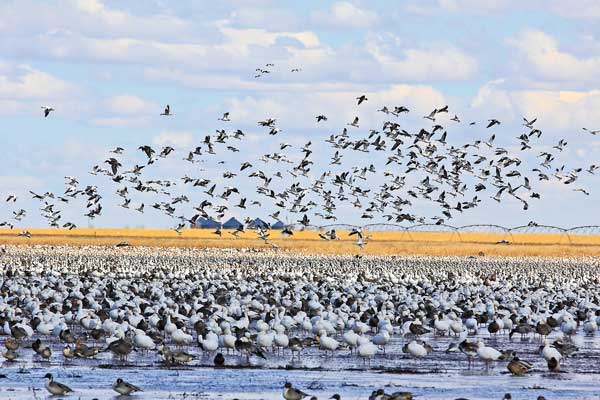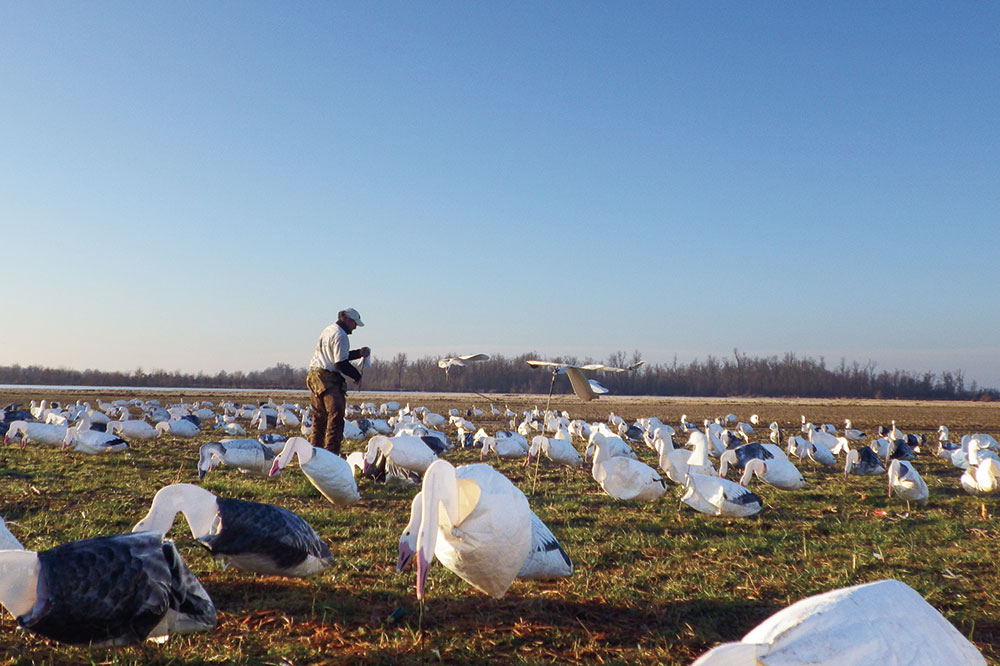June 03, 2015
By David Hart
 It was supposed to be the solution for too many geese and not enough nesting habitat. Biologists hoped electronic callers, unplugged shotguns, no limits and a season that stretched into May would bring snow goose numbers down to manageable numbers.
It was supposed to be the solution for too many geese and not enough nesting habitat. Biologists hoped electronic callers, unplugged shotguns, no limits and a season that stretched into May would bring snow goose numbers down to manageable numbers.
At first, it seemed to be working. More than 75,000 hunters swarmed the Central and Mississippi flyways, trailers packed with decoys and cases of shells. They followed the birds north during the spring flight, killing nearly 650,000 in 1999, the first year of the Light Goose Conservation Order.
Then things started to change. The spike in pressure only helped educate birds, and hunters quickly discovered chasing snow geese was nothing like hunting Canadas. Participation fell after that first season, dropping nearly in half by 2013.
"I think the novelty just sort of wore off when people realized what was required to hunt snow geese," says Nebraska Game and Parks waterfowl biologist Mark Vrtiska.
Advertisement
He doesn't think access has ever been an issue. Landowners often view the birds as pests and are usually willing to grant permission when hunters ask. Arkansas outfitter Adam Lyerly agrees.
"We've got a lot more outfitters than we had 10 years ago, but there is plenty of land available for the asking even now," he says. "There aren't nearly as many guys doing it on their own though. It's just a lot more difficult to kill snows than it used to be.
"You could do well with a couple hundred silo socks before everybody started hunting them. Now you need a thousand or more. There aren't many weekend warriors willing to go to all that expense and work."
Advertisement
Less Means More
The good news is the remaining hunters who continue to pursue snows in the spring tend to be more effective now than before. Despite the mounting challenges, along with declining participation, the harvest has actually increased since the conservation order went into effect. Hunters in the Mississippi and Central flyways killed more than 900,000 light geese in 2012.
It's still not enough. Not even close. The damage to the tundra — the sole reason for the conservation order — continues.
"There is no coastal salt marsh left in the Hudson Bay lowlands. There isn't a plant left," says American Museum of Natural History population ecologist Dr. Robert Rockwell, who has been studying snow geese for nearly five decades and witnessed the extent of the devastation first-hand. "It will be 50 years before it comes back, if it is given the chance to come back."
When biologists first saw the damage to the nesting grounds, some figured the birds would control themselves under the assumption that once there was nothing left to eat many would starve to death. That didn't happen.
"Once they ate all the salt marsh, they moved to freshwater marshes. Now we are seeing them around boreal forest ponds. We are seeing them in places we've never seen them before. They just adapt," says Rockwell, who adds that about 150 bird species share the same summer habitat as snow geese. "They are eating willows and all sorts of stuff we never imagined. If it's a plant, they will eat it. We don't know where it stops."
 Biologists acknowledge hunting is not a viable means of long-term population control. Even with absurdly liberal hunting restrictions, the number of geese continues to rise. There were about 800,000 light geese in 1970 and more than 5 million in 1999. Some estimates put the current population of mid-continent snows at 15 million or more.
Biologists acknowledge hunting is not a viable means of long-term population control. Even with absurdly liberal hunting restrictions, the number of geese continues to rise. There were about 800,000 light geese in 1970 and more than 5 million in 1999. Some estimates put the current population of mid-continent snows at 15 million or more.
"When we liberalized the bag limits and removed many of the restrictions, we thought we would see a decline in goose populations," says Rockwell. "What we didn't count on is that hunters would only take so many geese. There's only so many a person will shoot before he gets tired of cleaning and eating them."
Lyerly recalls a hunt where eight clients killed about 400 birds in a single morning. The group spent the rest of the day cleaning birds. The next morning they killed about 150 before they decided they didn't want to shoot anymore.
"They figured out you have to do something with them after you kill them," he says.
Doing What's Right
In some ways, agrees Rockwell, that's a positive testament to the ethics of waterfowlers. They actually want to do something with the birds they harvest. But at what point do ethics get pushed aside for the greater good? It's a question the wildlife community is wrestling with right now.
One potential solution is allowing hunters to sell goose meat. Creating a financial incentive would likely encourage more hunters to shoot more birds, says Vrtiska. He admits it's nothing more than an idea right now and one that would have to go through a lengthy bureaucratic process to get approved, assuming it can get past the intense public scrutiny it would likely draw.
"I don't know if people would want to buy goose meat," says Vrtiska. "It is a lean meat, so I could see a potential market. I think it's something worth exploring, but there's no telling if it will go anywhere."
Lyerly wouldn't necessarily want the opportunity to sell geese, although he would admittedly do so. Instead, he would like to see a streamlined donation program where hunters could get rid of any birds they don't want quickly and easily.
"We could feed third-world countries if we could just give them away and not worry about cleaning them at the end of a hunt," he says.
Other possibilities are equally drastic. Discussions within the waterfowl management community include everything from shooting geese during their migration to trapping and euthanizing them on their nesting grounds. The idea of poisoning them has even been discussed.
A paper co-authored by five wildlife management professionals examined hunter attitudes about those and other alternative population control methods. They found hunters were generally supportive of the idea of reducing light geese, but they didn't necessarily agree with the suggested methods.
Vrtiska, who co-authored that paper, said the takeaway was hunters acknowledged something needs to be done, as long as they are the ones to do it. Unless there are some dramatic changes in participation, though, that's unlikely to happen. He says hunters will always be part of the solution, but they clearly aren't the only solution. Something else needs to be done.
"It's hard to guess how this will all play out, but I'm pretty sure no matter what happens, it's going to be controversial," says Vrtiska. "We are going to have to make a decision, though, and I'd prefer we do it sooner rather than later."
